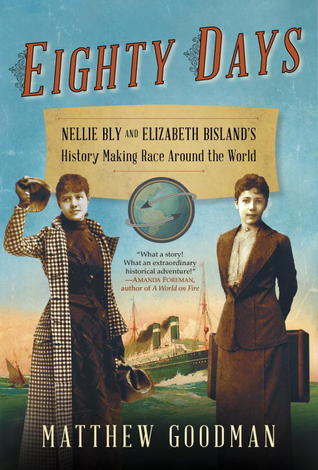Today I'm looking at a book about the first official race by an individual to circumnavigate the globe in eighty days or less. A long, long time ago I actually talked about the book that inspired this challenge, which remains a classic piece of literature. What may surprise some people is that a female reporter, Nellie Bly, was the first person to accomplish this feat in seventy-two days. What is even less known is that there were actually two women attempting to circumnavigate the world at the same time. While Nellie Bly was travelling east for The World newspaper, Elizabeth Bisland had been sent west by Cosmopolitan in an attempt to beat Nellie Bly at her own challenge. While Bly remains famous in large part because of her trip around the world, Bisland remains practically unknown today. In this work Goodman not only talks about the lives of both women, but also the world which they circumnavigated.
Goodman spends some time comparing and contrasting both Bly and Bisland. Bly, born Elizabeth Cochran in Pennsylvania, was the daughter of a prominent local merchant, however her father's death left her mother and her siblings fairly destitute and forced Nellie's mother and Nellie to work for a living. Nellie did a variety of odd jobs before sending a letter to a Pittsburgh newspaper to protest an article stating a woman's proper sphere was in the home. Bly soon found herself hired as a female reporter and eventually made her way to New York. Despite strong opposition to women in the newspaper field, most of them being relegated to the society pages, Bly became an undercover investigative journalist. Her first report was to infiltrate the Blackwell Island Insane Asylum and report on the abhorrent conditions there, truly sensational news, but she investigated working conditions and corruption throughout New York.
Elizabeth Bisland was born to a slave-owning family in Louisiana and actually spent a good portion of the Civil War in New York. After the Civil War, the Bisland family found much of their wealth destroyed and their existence considerably more difficult. However, Elizabeth grew up in a literature-rich environment, reading many English novels during her childhood and having the experience of her poet mother. Bisland eventually sent a poem to a local newspaper and was delighted when it was published, launching a literary career that eventually also took her to New York. While Bly was doing investigative journalism for the daily newspaper The World, Bisland was doing reviews of new literature for the monthly magazine Cosmopolitan. While Bly seems the perfect individual to send on a globe-trotting adventure, Bisland was extremely reluctant to go and did not enjoy the attention being involved in a global race brought her.
This book is rather wide in its focus, going well beyond the adventures of Bly and Bisland as they raced around the world. And this is fairly understandable as, once Bly and Bisland were on a train or steamship, there wasn't quite a lot for them to do but wait. The biographies of both women are helpful and it's interesting to see what happened to both of them after the race was over. Bisland happily faded into relative obscurity, being the runner-up in the race, and continued with her writing career, while Bly enjoyed a brief surge of popularity. Unfortunately Bly became involved with a libel lawsuit brought against The World and left the newspaper. She struggled for a number of years before marrying a millionaire which later brought its own set of problems. In her later years Bly returned to newspaper reporting and remained a champion for the poor and marginalized.
In addition to talking about the women sent around the world, Goodman spends a good chunk of time talking about the world that they saw. He talks about the newspaper industry as it had grown in the late nineteenth century, dominated by individuals such as Joseph Pulitzer and William Randolph Hearst who had their own fierce rivalry. Goodman also talks about the travel conditions during the era, whether by train or by the ocean-going steamers which were the only means of long-distance travel in the late nineteenth century. There is a particularly fascinating segment about conditions in the boiler rooms of steamships which I found especially interesting. There is some time spent about the various locations that Bly and Bisland were able to visit, such as Bly's visit with Jules Verne in France or Bisland's stay in Yokohama, but Goodman does a good job of emphasizing how both women spent most of their time racing around the world travelling rather than taking in the sights.
I do want to say one of the things I noticed which got mentioned by contemporaries again and again was the physical appearance of both Bly and Bisland, something which women are still struggling with a hundred and twenty years later. Both women were accomplished writers within their own subject fields, but contemporaries describing them felt it was necessary to describe both women as attractive. Even today talented and accomplished women get comments on their physical appearance, while men do not. So in a way it's kind of frustrating that we're still struggling against attitudes that are well over a century old.
Overall I think this book was okay. Goodman stretches the book out by providing a lot of background context, but I think that's really necessary for most readers to understand the world that Bly and Bisland were exploring in the 1890's. Plus I think it's important to talk about Elizabeth Bisland who was press-ganged into doing what basically amounted to a publicity stunt with no preparation whatsoever. I also enjoy the irony of the first person going around the world in less than eighty days being unable to vote at the time. Anyway, if you're interested in badass women of history this is definitely worth checking out.
- Kalpar


No comments:
Post a Comment